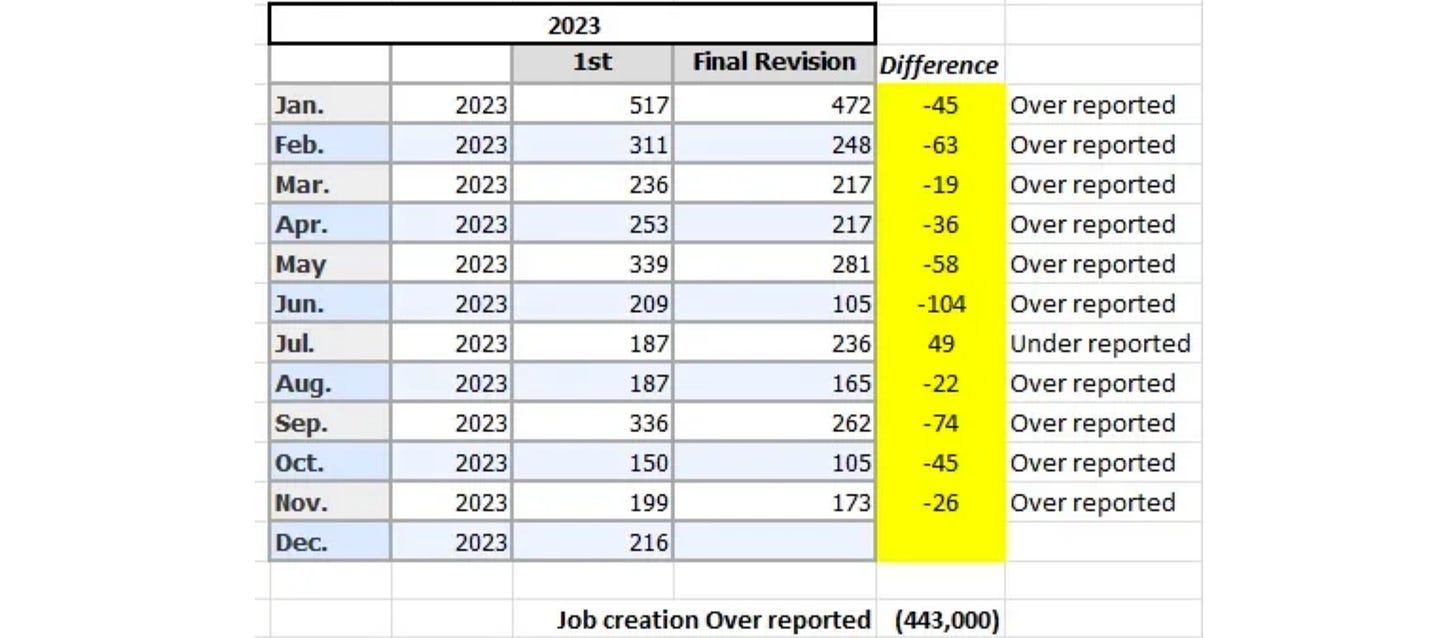Market News
Stocks in the US finished a volatile session flat on Friday, as traders digest the latest economic data and assess the future path of the US monetary policy.
All the major indexes ended near the flatline, halting a 9-week win streak, with the Nasdaq 100 booking its sixth day of losses.
Among stocks, Nvidia and AMD shares pulled through the volatility to add over 1.8% each.
Airlines rebounded for a second day in a row, breaking a seven-day losing streak, following the Japan Airlines crash in Tokyo.
American Airlines, Delta and United gained over 3.1%
Macro Perspectives
We had the December jobs report on Friday and the media celebrated the numbers; CNBC called it "much better than expected." Business Insider called it "surprisingly hot." Yahoo Finance says today's report "could delay interest rate cuts."
Let's take a look.
Building on my previous note, the normalization of the job market (post-pandemic) back to pre-pandemic levels has been the clear trend. This after the Fed ratcheted rates up, to over 5%, because it was concerned about the hot job market feeding the inflation fire. The current numbers: 3.7% unemployment was steady, and the BLS reported 216,000 jobs added in December (estimates were for 170k).
That's about the average monthly job growth for the seven years prior to the pandemic - the economy wasn't great during that time and the Fed was in a highly stimulative stance.
So, these numbers do nothing to change the building surprise risk, that the Fed will have to move sooner with rate cuts to avoid inducing deflation (a fall in prices).
Why would the fall in prices be something to avoid, after we've had (at least) a huge surge in the level of broad prices over the past three years? Because deflation would induce an economic downward spiral, and increase the burden of the record government debt.
We wouldn't get the extent of economic boom necessary to inflate away the massive debt boom of the past three years. Deflation would lead to debt downgrades. Debt downgrades would lead to defaults. Defaults would lead to currency devaluations and economic depression.
So, we don't want deflation. The data is telling us we should be concerned about deflation, driven by overly restrictive monetary policy that is getting more and more restrictive as inflation falls (a self-reinforcing cycle). Check out this chart of services employment reported on Friday.
The past three times services employment was contracting at this level we were in recession, and the Fed was well into an easing cycle. With this in mind, let's take a look at how the government's Bureau of Labor Statistics has reported on the health of the job market.
Here's a look at 2021 …
As we know, the inflation fire was burning in 2021, driven by the textbook inflationary ingredients of a massive boom in the money supply. Yet the Fed continued its emergency monetary policies all along the way (zero rates + QE), dismissing the rise in prices as "transitory."
Congress used the Fed's assessment to rationalise even more fiscal spending (more fuel for the inflation fire).
How could the Fed justify its claim that inflation was "transitory?" A relatively modest job market recovery. But as you can see in the table above, it turns out that the BLS revised UP eleven of the twelve months of nonpayroll numbers in 2021. For the full year, the initial monthly reports UNDER reported job creation by 1.9 million jobs.
As we know, the Fed was wrong on inflation, and well behind the curve in the inflation fight. Under reported jobs were arguably an ingredient in the Fed mistake of 2021. At the very least, under reported jobs kept the interest rate market at bay, enabling the Fed to ignore inflation.
Now, let's look at 2023 …
As we know, the Fed continued raising rates through July of last year and along the path of its tightening campaign, the Fed was explicitly trying to slow the job market. What did the BLS do along the way? They OVER reported job creation.
As you can see in the table above, through November, the BLS revised DOWN ten of the eleven months of payroll numbers in 2023 it's safe to expect they will do the same with the most recent number that was reported.
So, in sum, we're looking at close to half a million jobs less than the BLS initially reported last year. Will it contribute to another Fed mistake, this time in the opposite direction, responding too slowly to a deflation threat?








Circling back on this, BLS revisions to the 2024 guestimates were revised some 600k lower... again! That's quite a significant error margin over 2 years, would be interesting to dive again in details in one of your coming notes :)